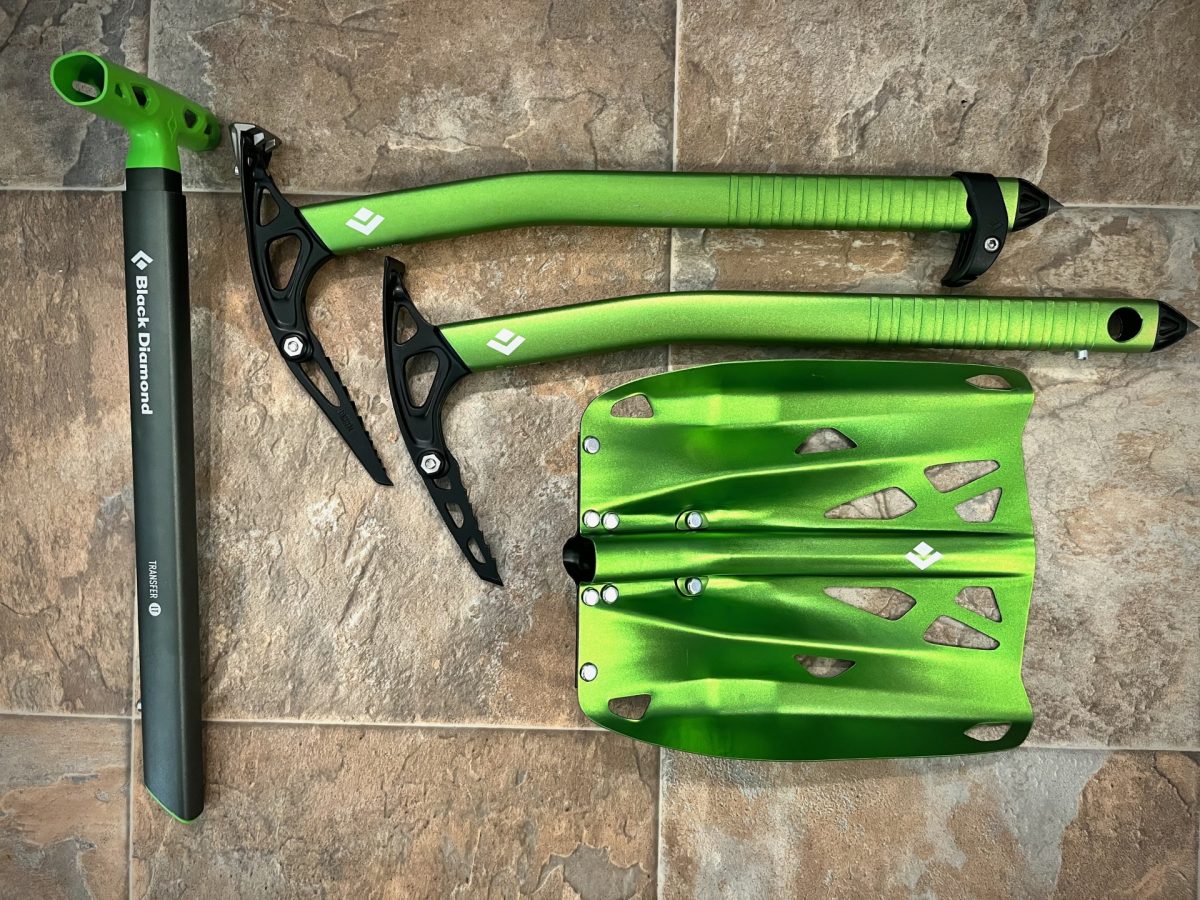
Behold the green. BD’s Venom LT axes and the Transfer LT shovel: an integrated system built for more technical terrain.
Black Diamond retools their lightweight technical tools with ice climbing capabilities in the new Venom LT axes. And for those looking to streamline the gear, BD offers up a slick new shovel, the Transfer LT. Here’s our first look at this promising collection.
The last 4-5 years have seen a boom in lightweight, technically capable ice tools built for ski mountaineering and lightweight alpinism. Petzl opened the floodgates for this category with the Gully Ice Axe. With a fixed, recurved pick, a hammer or adze option, and an included pommel, these tools were a massive leap forward in the technical capabilities of a super light ski mountaineering ice axe. After a few years as the only real contender in this spot, the likes of Blue Ice with the Akila, Grivel with the Ghost, and now Black Diamond with the Venom LT provide several options with different strengths and weaknesses to consider.

An assortment of lighter weight yet technically capable axes: (L-R) BD Venom LT Classic, BD Venom LT Tech (hammer), BD Venom Ice Axe, (older) Camp Corsa Nanotech, Petlz Gulley (hammer), and Blue Ice Akila (hammer).
Design Differences and Considerations
There are a few key considerations when deciding which of the ultralight ice tools to purchase. Having a few options on the market benefits the consumer here as we get the luxury of choosing exactly where our priorities lie and generally being able to find an excellent fit for our needs.
A few features to consider:
Spike: The Petzl Gully and Grivel Ghost tools have a diagonal cut-off aluminum shaft – excellent for stowing inside your pack, less excellent for plunging on firm snow. The BD Venom LT and Blue Ice Akila tools have steel spikes that will work better in firm snow but could damage the inside of a pack or rip a jacket.
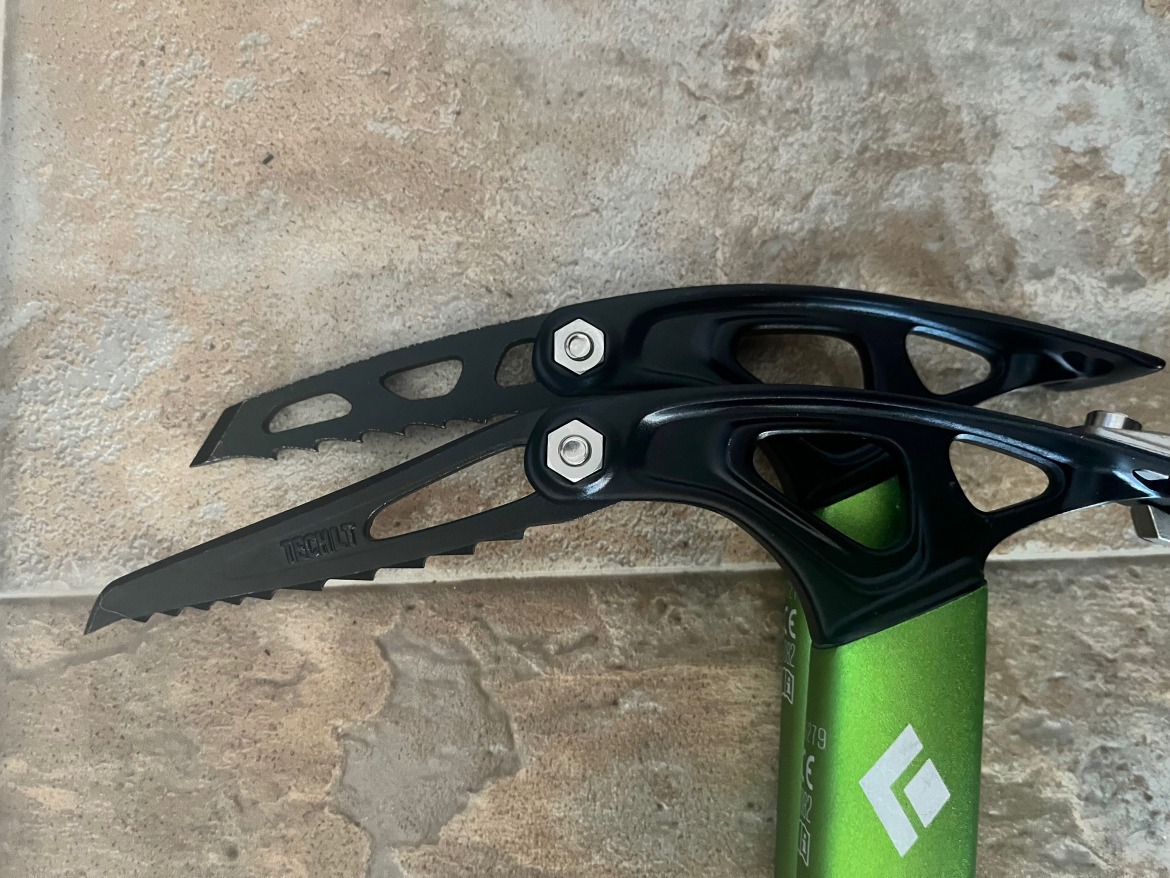
A closeup shot of the BD Venom LT classic pick (top) and the longer, more aggressive tech pick (bottom)standard on the Venom LT Tech.
Replaceable pick: The BD tools are the first in this category to offer a replaceable pick – a strong consideration if you plan to spend any significant amount of time ice/mixed climbing with these tools. It’s nice to sharpen the picks without worry and not need to replace the whole tool if you bend a pick. About five years into Gully ownership, this hasn’t been an issue for my occasional jaunts into ice/mixed terrain.
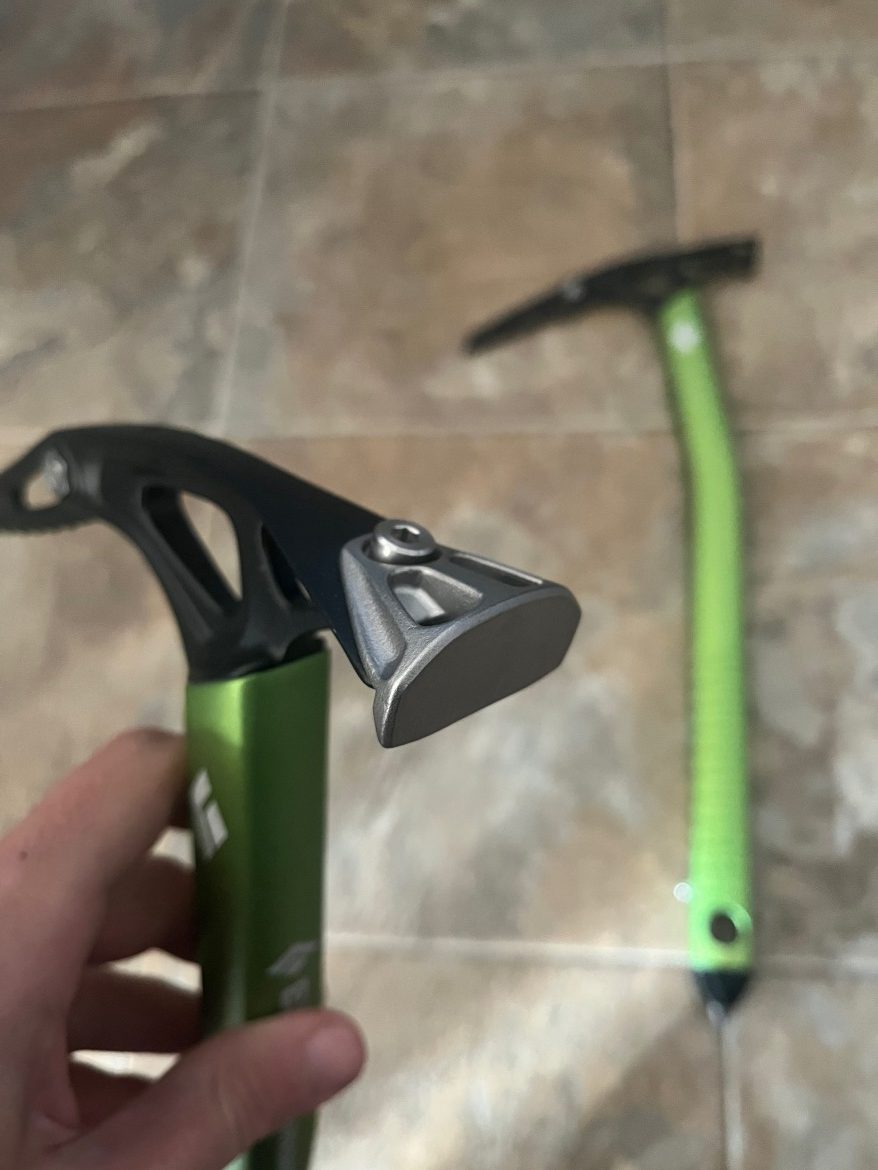
Here is the hammer attachment for the BD Venom LT (Classic or Tech model). The hammer attachment is modular and secures with a bolt over the adze.
Hammer: My Gully hammer is beat – testing and placing pitons with the Gully requires a light touch, and I have heard of numerous breakages over the years. The Grivel hammer seems similarly wimpy, but the bolt-on BD and larger/better reinforced Blue Ice hammers are confidence-inspiring. Another useful addition of the BD tools – the hammer is added atop the adze with a bolt-on connection.
Venom LT Design Primer
The Venom LT has a similar bent aluminum shaft to every other lightweight tool discussed above. At first glance, the whole package looks similar to the Gully or Akila, but the details change from here. Starting at the spike, it is a plastic cone with a sharp steel tip. I may sand or file this a bit to reduce the likelihood of a torn pack or jacket. (Important for those stowing aces internally.) The head of the tool is unique as well – beyond being modular, BD forges it from aluminum. This material choice will be interesting to keep an eye on from a durability perspective, as each direct competitor uses a one-piece steel head: time will tell.
The Venom LT comes in a “classic” layout – straighter pick, no pommel, adze layout, and a “tech” setup with a recurved pick, sliding pommel, and hammer. (Recurve picks are better for steeper ice, and straighter picks are more advantageous for snow.) I have one of each axe for the review, but I plan to swap for the tech pick and add a pommel to my classic tool before venturing into technical terrain. I’m excited to bash some pitons with the hammer – it seems well-built and adds a nice heft to the swing weight.
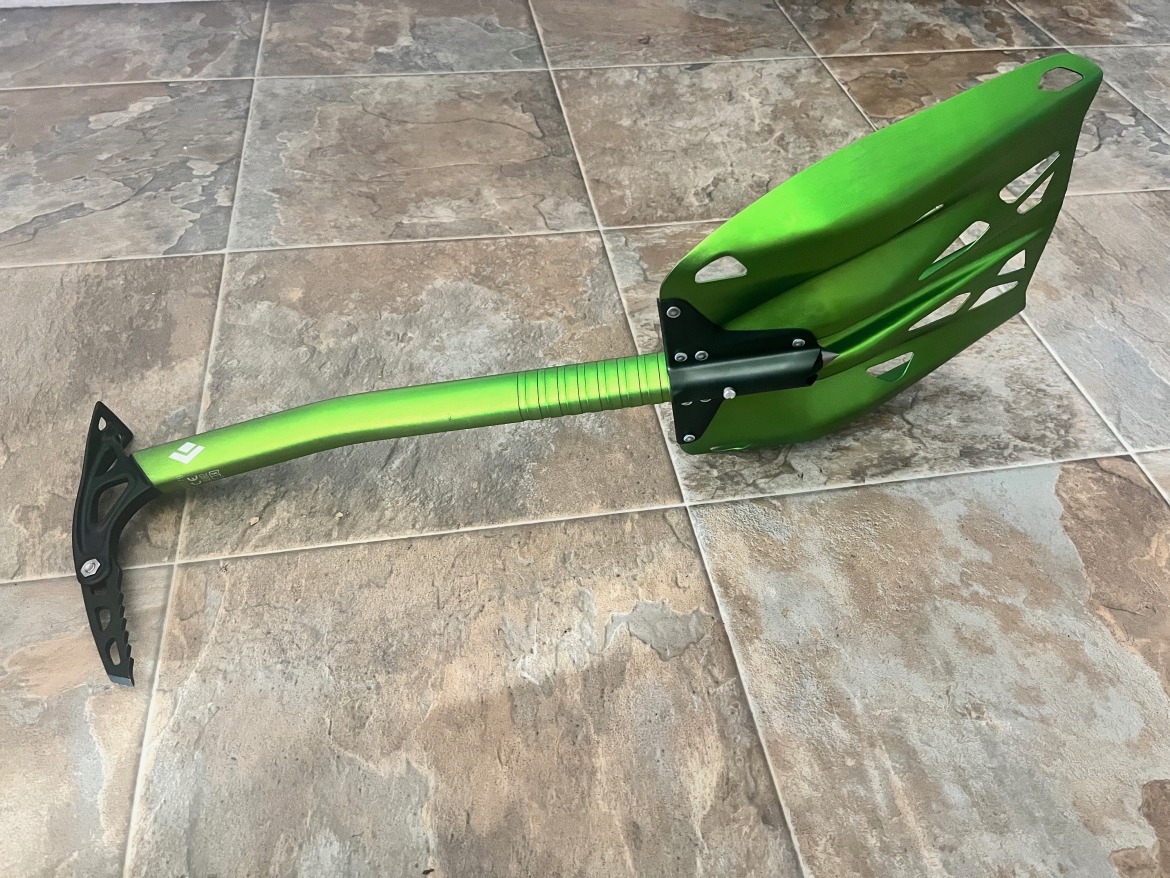
The Venom LT axes will suffice as the Transfer LT shovel handles when you want to minimize the gear selection and leave the standard shaft home.
Black Diamond LT Line/Shovel-Axe Integration
BD began releasing the green anodized “LT” line last year. Along with the tools, there is a shovel, the Transfer LT – which in addition to being lightweight and well built at first glance, is compatible with the Venom LT tools as a “Shaxe” type setup. The line also includes clothing, a tiny transceiver, and an excellent-looking snow saw that closely resembles my trusty Primo saw.
The Venom LT is certainly the most modular of the tools in this category, with pick options (yet to be released, but at least a “tech” and “classic”), the à la carte hammer, and pommels. I still need to, but I plan to play with Petzl’s pick weights as an aftermarket addition to improve the ice climbing performance. (Adding more mass to a pick helps the pick penetrate ice better.)
Regarding the ice tool-shovel handle compatibility, I imagine I will carry the normal shovel handle 90% of the time. The other 10% amounts to big days with low avalanche hazards and later season tours when I sometimes debate bringing avalanche gear along at all. The added functionality of an extendable, ergonomic shovel handle is worth it to me most any time there is a high likelihood of using the shovel.
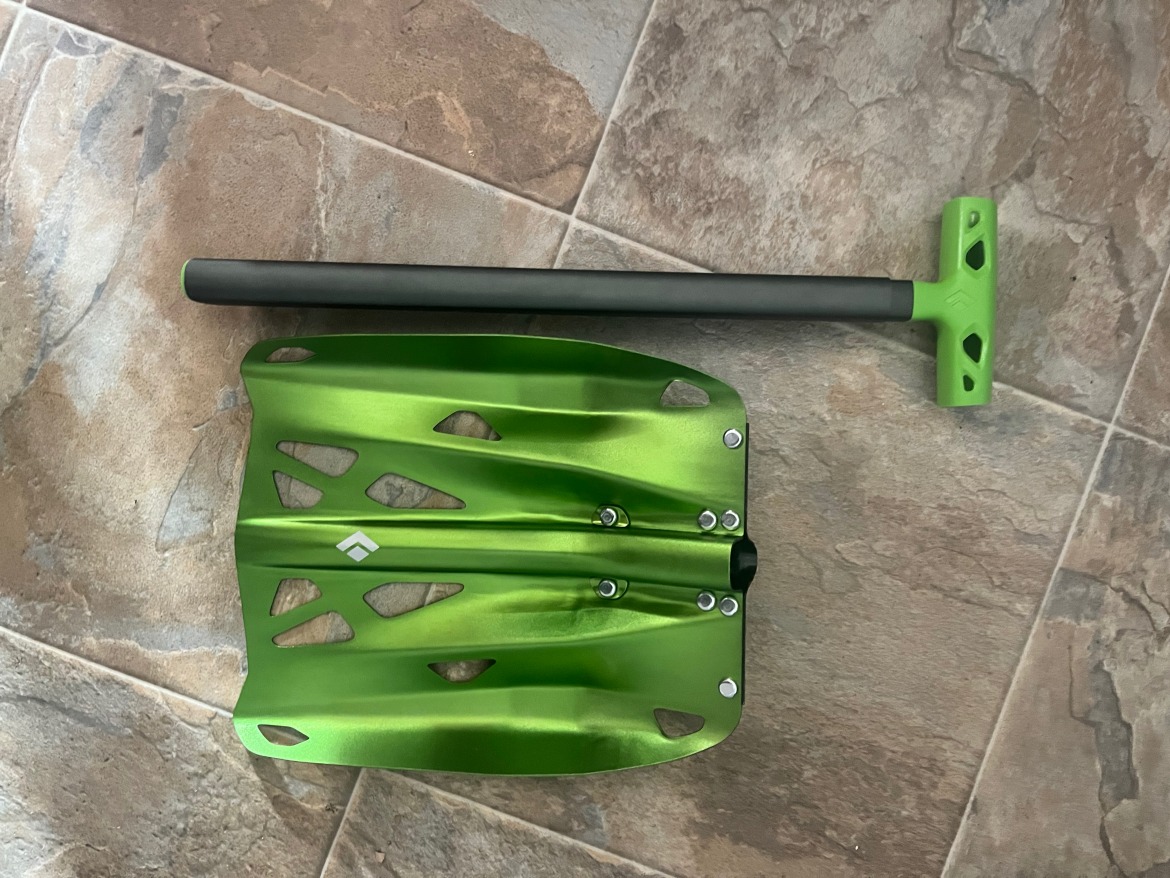
BD claims it is the lightest UIAA-certified shovel, a solid standard to look for in lightweight shovels as it ensures minimum ergonomic and construction requirements.
Transfer LT Shovel Design Primer
A few quick notes on the Transfer LT shovel design: BD claims it is the lightest UIAA-certified shovel, a solid standard to look for in lightweight shovels as it ensures minimum ergonomic and construction requirements. The blade fits right in between two popular lightweight shovels size-wise. At 550 cm^2, it’s a bit bigger than the Mammut Alugator Light (508 cm^2), but slightly smaller than the BCA Dozer 1T-UL (621 cm^2). It’s a bit lighter than these options, too, at 408g (claimed) relative to 439g for the BCA and 475g for the Mammut.

The Transfer LT has a low profile and robust looking riveted shaft connection that seems like it will hold up better than some of the welded attachment sleeves I’ve seen fail.
Beyond the specs, the Transfer LT has a low profile and robust looking riveted shaft connection that seems like it will hold up better than some of the welded attachment sleeves I’ve seen fail. A small detail I appreciate is the lack of a “catch” when the handle is in the closed position. Often this means the shaft extends as I pull it out of the sleeve in my pack – a great alternative to the frequently frozen-in-collapsed position flaw of some previous shovels. I’m excited to use this shovel as a daily driver this winter.
Conclusion
I have access to and have used the Petzl and Blue Ice competitors and plan to compare them thoroughly. Once I’ve put these tools and shovel through the wringer, I’ll report with an in-depth review. In the meantime, if there are pressing questions or comparisons desired, don’t hesitate to ask in the comments, and I can try to answer as best I can.
List Prices:
Venom LT Tech Piolet: $179.95
Venom LT Classic Piolet: $129.95
Transfer LT Shovel: $99.95
Gavin is a mountain guide and gear fanatic based in Jackson, WY. His endless pursuit of gear perfection led to starting a pack company, Apocalypse Equipment in 2019. He has a degree in Nordic skiing and mechanical engineering from the University of New Hampshire and worked as a ski shop tech prior to getting his dream job as a WildSnow contributor.
